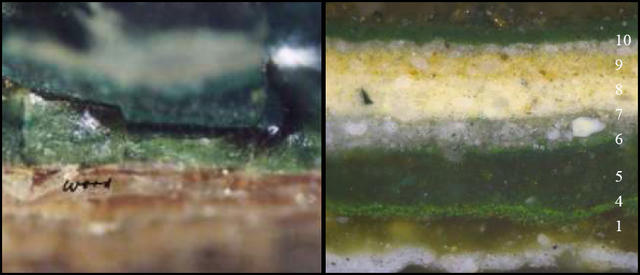
Amazingly, the shutters also appeared to have never been stripped of their paint. This meant that the original ca. 1812 Madison-era paint had survived underneath the more modern 19th century layers. After analysis by Dr. Buck, it was discovered that the ca. 1812 paint was made from a green pigment called verdigris. Verdigris is made from oxidized copper and was a common, if expensive, color used for architectural paints in the 18th and 19th centuries. Verdigris pigmented paints were also commonly applied to exterior architectural elements, such as shutters, and to chairs and benches that were used outside on porches or in gardens. When freshly applied, verdigris was often referred to as a bright “grass green” color in Madison’s period, although within ten to twenty years the unstable pigment notoriously darkened into a deep brownish, almost black color.

©The Montpelier Foundation and Dr. Susan Buck
|
|
Photomicrographs made by Dr. Susan Buck of paint samples taken from the ca. 1812 shutters at Montpelier. The image on the left is a detail of the ca. 1812 verdigris paint while the image on the right shows the sample's paint stratigraphy. |
















